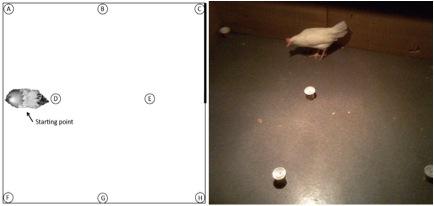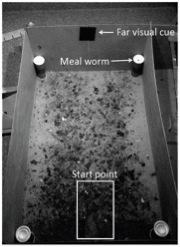The effects of early stress on life-time strategies of behaviour and coping in chickens (Gallus gallus)
Methods
Within a larger project relating to early stress its behavioural effects and heritability, I focused on spatial learning in chickens. The chosen stressor for the experiment was social isolation, for its effect on social species and its relatively mild intensity (as opposed to common experimental stressors such as physical restriction, or foot shocks). The stressor began on the third day after hatching, occurring for one hour per day during the first week, two hours per day during the second, and three hours per day in the third. Half the chicks were exposed to the stress treatment, and the other remained as an un-stressed control group.
I performed the spatial learning behavioural tests when the chickens were between 16 and 20 weeks old. After the first day involving a one-hour habituation period, testing occurred over four consecutive days. Test sessions were 10 minutes long, and involved placing chickens in a 2m3 arena. Eight reward cups containing mealworms were equally spaced within the arena. If a chicken increased the number of cups that it ate the mealworm from over the test days, learning is said to have occurred. Chickens that ate more simply because they moved more (were more explorative) were accounted for by recording the number of times a chicken visited a cup, in relation to the number of worms eaten.


After behavioural testing, stressed birds were paired with stressed birds, and control birds with control birds, and an offspring generation was formed to see if the effects of stress were heritable. The offspring were later tested using a different spatial test than the parents.
At 9-11 weeks old, the offspring chickens were trained for 5 days in a spatial arena with four mealworm reward cups. Testing occurred over two separate blocks of five sessions, involving the consistent placement of a single mealworm. The speed of approach, and the duration of time spent near the cup with the mealworm were used as an indicator of learning. If a chicken rapidly approached, and spent time near the mealworm cup, it was said to have learned the location of the reward. Probe tests were delivered to determine the validity of the test, which were, unfortunately, inconclusive.
Responsible for this page:
Director of undergraduate studies Biology
Last updated:
05/19/11
